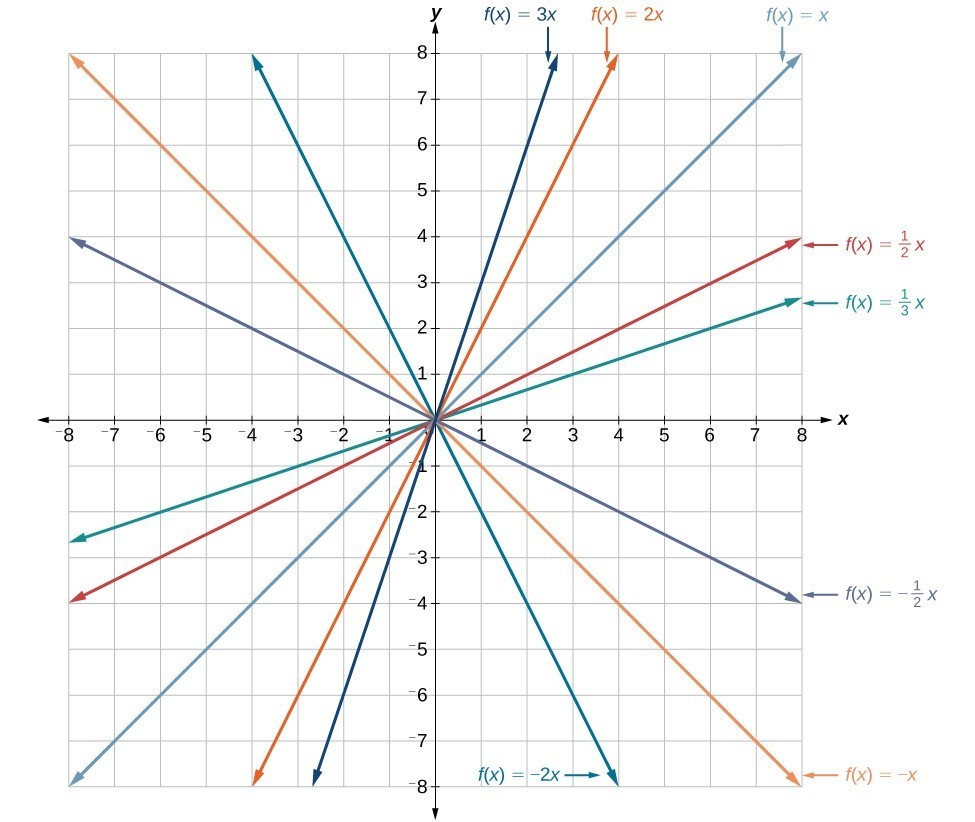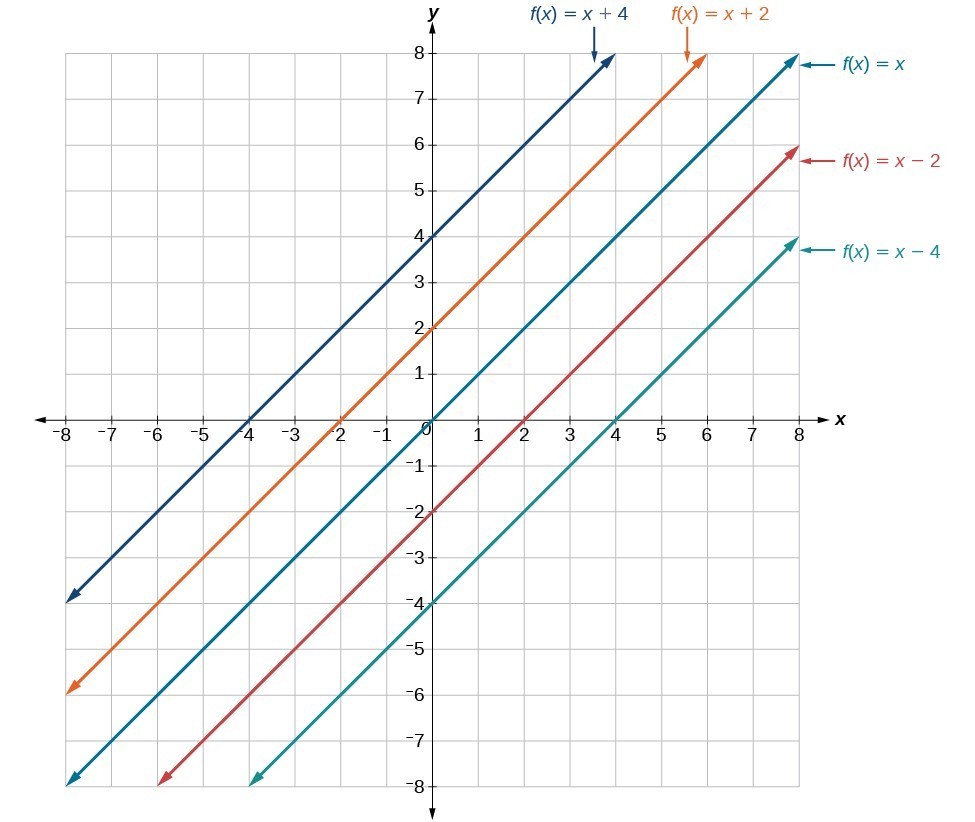Learning Outcomes
- Graph a linear function by plotting points
- Graph a linear function using the slope and y-intercept
- Graph a linear function using transformations
recall graphing functions
Recall that you can graph a linear function by evaluating it at chosen inputs to obtain a table of points that exist on the line, then plotting those points and drawing a line between them. Since it only takes two points to describe a line, this method works very well for graphing linear functions that yield integer output for integer input.
This section provides this method along with two other good ways to draw a quick, accurate sketch of a linear function.
We previously saw that that the graph of a linear function is a straight line. We were also able to see the points of the function as well as the initial value from a graph.
There are three basic methods of graphing linear functions. The first is by plotting points and then drawing a line through the points. The second is by using the y-intercept and slope. The third is applying transformations to the identity function [latex]f\left(x\right)=x[/latex].
Graphing a Function by Plotting Points
To find points of a function, we can choose input values, evaluate the function at these input values, and calculate output values. The input values and corresponding output values form coordinate pairs. We then plot the coordinate pairs on a grid. In general we should evaluate the function at a minimum of two inputs in order to find at least two points on the graph of the function. For example, given the function [latex]f\left(x\right)=2x[/latex], we might use the input values 1 and 2. Evaluating the function for an input value of 1 yields an output value of 2 which is represented by the point (1, 2). Evaluating the function for an input value of 2 yields an output value of 4 which is represented by the point (2, 4). Choosing three points is often advisable because if all three points do not fall on the same line, we know we made an error.
How To: Given a linear function, graph by plotting points.
- Choose a minimum of two input values.
- Evaluate the function at each input value.
- Use the resulting output values to identify coordinate pairs.
- Plot the coordinate pairs on a grid.
- Draw a line through the points.
Example: Graphing by Plotting Points
Graph [latex]f\left(x\right)=-\frac{2}{3}x+5[/latex] by plotting points.
Try It
Graph [latex]f\left(x\right)=-\frac{3}{4}x+6[/latex] by plotting points.
Graphing a Linear Function Using y-intercept and Slope
Another way to graph linear functions is by using specific characteristics of the function rather than plotting points. The first characteristic is its y-intercept which is the point at which the input value is zero. To find the y-intercept, we can set [latex]x=0[/latex] in the equation.
tip for success
Keep in mind that if a function has a y-intercept, we can always find it by setting [latex]x=0[/latex] and then solving for [latex]y[/latex].
The other characteristic of the linear function is its slope [latex]m[/latex], which is a measure of its steepness. Recall that the slope is the rate of change of the function. The slope of a linear function is equal to the ratio of the change in outputs to the change in inputs. Another way to think about the slope is by dividing the vertical difference, or rise, between any two points by the horizontal difference, or run. The slope of a linear function will be the same between any two points. We encountered both the y-intercept and the slope in Linear Functions.
Let’s consider the following function.
[latex]f\left(x\right)=\frac{1}{2}x+1[/latex]
The slope is [latex]\frac{1}{2}[/latex]. Because the slope is positive, we know the graph will slant upward from left to right. The y-intercept is the point on the graph when x = 0. The graph crosses the y-axis at (0, 1). Now we know the slope and the y-intercept. We can begin graphing by plotting the point (0, 1) We know that the slope is rise over run, [latex]m=\frac{\text{rise}}{\text{run}}[/latex]. From our example, we have [latex]m=\frac{1}{2}[/latex], which means that the rise is 1 and the run is 2. Starting from our y-intercept (0, 1), we can rise 1 and then run 2 or run 2 and then rise 1. We repeat until we have multiple points, and then we draw a line through the points as shown below.

A General Note: Graphical Interpretation of a Linear Function
In the equation [latex]f\left(x\right)=mx+b[/latex]
- b is the y-intercept of the graph and indicates the point (0, b) at which the graph crosses the y-axis.
- m is the slope of the line and indicates the vertical displacement (rise) and horizontal displacement (run) between each successive pair of points. Recall the formula for the slope:
[latex]m=\frac{\text{change in output (rise)}}{\text{change in input (run)}}=\frac{\Delta y}{\Delta x}=\frac{{y}_{2}-{y}_{1}}{{x}_{2}-{x}_{1}}[/latex]
Q & A
Do all linear functions have y-intercepts?
Yes. All linear functions cross the y-axis and therefore have y-intercepts. (Note: A vertical line parallel to the y-axis does not have a y-intercept. Keep in mind that a vertical line is the only line that is not a function.)
How To: Given the equation for a linear function, graph the function using the y-intercept and slope.
- Evaluate the function at an input value of zero to find the y-intercept.
- Identify the slope.
- Plot the point represented by the y-intercept.
- Use [latex]\frac{\text{rise}}{\text{run}}[/latex] to determine at least two more points on the line.
- Draw a line which passes through the points.
Example: Graphing by Using the y-intercept and Slope
Graph [latex]f\left(x\right)=-\frac{2}{3}x+5[/latex] using the y-intercept and slope.
Try It
Find a point on the graph we drew in Example: Graphing by Using the y-intercept and Slope that has a negative x-value.
Graphing a Linear Function Using Transformations
Another option for graphing is to use transformations on the identity function [latex]f\left(x\right)=x[/latex]. A function may be transformed by a shift up, down, left, or right. A function may also be transformed using a reflection, stretch, or compression.
Vertical Stretch or Compression
In the equation [latex]f\left(x\right)=mx[/latex], the m is acting as the vertical stretch or compression of the identity function. When m is negative, there is also a vertical reflection of the graph. Notice that multiplying the equation [latex]f\left(x\right)=x[/latex] by m stretches the graph of f by a factor of m units if m > 1 and compresses the graph of f by a factor of m units if 0 < m < 1. This means the larger the absolute value of m, the steeper the slope.

Vertical stretches and compressions and reflections on the function [latex]f\left(x\right)=x[/latex].
Vertical Shift
In [latex]f\left(x\right)=mx+b[/latex], the b acts as the vertical shift, moving the graph up and down without affecting the slope of the line. Notice that adding a value of b to the equation of [latex]f\left(x\right)=x[/latex] shifts the graph of f a total of b units up if b is positive and |b| units down if b is negative.

This graph illustrates vertical shifts of the function [latex]f\left(x\right)=x[/latex].
Using vertical stretches or compressions along with vertical shifts is another way to look at identifying different types of linear functions. Although this may not be the easiest way to graph this type of function, it is still important to practice each method.
How To: Given the equation of a linear function, use transformations to graph the linear function in the form [latex]f\left(x\right)=mx+b[/latex].
- Graph [latex]f\left(x\right)=x[/latex].
- Vertically stretch or compress the graph by a factor m.
- Shift the graph up or down b units.
Example: Graphing by Using Transformations
Graph [latex]f\left(x\right)=\frac{1}{2}x - 3[/latex] using transformations.
Try It
Graph [latex]f\left(x\right)=4+2x[/latex], using transformations.
Q & A
In Example: Graphing by Using Transformations, could we have sketched the graph by reversing the order of the transformations?
No. The order of the transformations follows the order of operations. When the function is evaluated at a given input, the corresponding output is calculated by following the order of operations. This is why we performed the compression first. For example, following order of operations, let the input be 2.
[latex]\begin{array}{l}f\text{(2)}=\frac{\text{1}}{\text{2}}\text{(2)}-\text{3}\hfill \\ =\text{1}-\text{3}\hfill \\ =-\text{2}\hfill \end{array}[/latex]
Candela Citations
- Revision and Adaptation. Provided by: Lumen Learning. License: CC BY: Attribution
- Question ID 114584, 114587. Authored by: Lumen Learning. License: CC BY: Attribution. License Terms: IMathAS Community License CC-BY + GPL
- College Algebra. Authored by: Abramson, Jay et al.. Provided by: OpenStax. Located at: http://cnx.org/contents/9b08c294-057f-4201-9f48-5d6ad992740d@5.2. License: CC BY: Attribution. License Terms: Download for free at http://cnx.org/contents/9b08c294-057f-4201-9f48-5d6ad992740d@5.2
- Question ID 69981. Authored by: Majerus,Ryan. License: CC BY: Attribution. License Terms: IMathAS Community License CC-BY + GPL
- Question ID 88183. Authored by: Shahbazian,Roy. License: CC BY: Attribution. License Terms: IMathAS Community License CC-BY + GPL
![The graph of the linear function [latex]f\left(x\right)=-\frac{2}{3}x+5[/latex].](https://s3-us-west-2.amazonaws.com/courses-images/wp-content/uploads/sites/896/2016/10/21184320/CNX_Precalc_Figure_02_02_0012.jpg)





